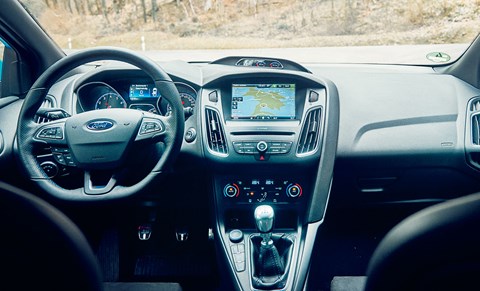► Focus RS battles it out with 718 Boxster and M2
► Three very different drivers’ cars
► Can the high-performance Focus match the heavy-hitters?
For us they’re 2016’s three sports car superheroes, united to save fun-starved drivers with analogue driving thrills on a plausible budget. Each has a unique talent, but only one will conquer…
As a threesome, the BMW M2, third-generation Ford Focus RS and updated Porsche Boxster S with its new 718 designation don’t exactly appear to stand direct comparison. After all, there’s no hiding the obvious reality that one is a coupe, one is a roadster and one – heaven forefend – is a jumped-up family hatchback, let alone the varying choice of engine position and power distribution.
But there’s also no denying that collectively they are three of today’s hottest fun-to-drive cars. In a fast-changing automotive world that’s now all too often dominated by digitalisation, autonomous driving and alternative powerplants, 2016 has yielded three down-to-earth playthings that are surprisingly good at blending heritage and innovation, ability and affordability. Bring them on.
Affordability is always relative, of course. At £29,995 the Focus is a full £15.5k less than the M2 at £45,575 – which is itself more than £7000 cheaper than the most powerful 718 variant at launch, the £52,817 Boxster S. Pricing for the latter pairing includes their optional seven-speed paddleshift transmissions; since a stick-shift six-speed is your only choice in the Ford, the manual versus automatic debate joins this already complex equation.
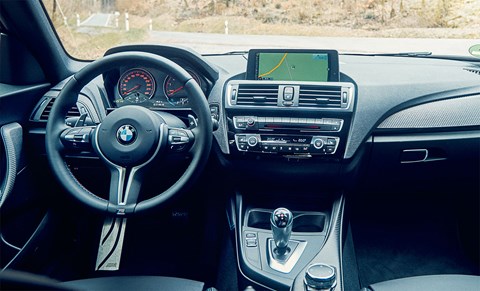
All three rely on turbocharging for improved potency and on-paper parsimony now that the Porsche’s preceeding flat-six has succumbed to a new-fangled forced-induction flat-four, so that’s one definite point of similarity. All three also have a rabid legion of fans, built on past glory and as ready to pounce on any perceived new-generation shortcomings as they are to malign any rival.
Still, when it comes to the crunch, value for money and product quality are the key yardsticks. In this case, that’s quality of the kind that triggers moist palms and bright eyes, draws the line between scent and fug, creates loudness or beautiful noise, grabs you by the adrenalin pump and over time has the addictive effect of a drug.
Some qualities are so obviously objective that one is inclined to instantly put numbers on them. Other traits are better judged by subjective perception, which means that soft values such as rejection and desire are not always backed up by hard facts. These cars live or die with their manipulation of our emotions. On then, to innovation and ability.
Porsche 718 Boxster: the most contentious?
We start with the Boxster – the newest and perhaps most contentious of our trio thanks to the death knell it rings for the naturally aspirated six-cylinder Porsche engine; once the Cayman goes turbo this year, only top-dollar purist 911s will remain free from additional plumbing and – say it ain’t so? – the associated dulling of throttle responses.
But the first test is whether this new four-cylinder unit can raise aural goosebumps in the manner of its illustrious predecessor; a single twist of the car-shaped ignition key is all it takes to make a whole forest of fir trees swing their needles towards the raucous intruder.
It does sound good, the new four-cylinder boxer, this 2.5-litre S unit clearly exhibiting the two-tone, off-beat burble of a horizontally-opposed four, like a Subaru – or, as the engineers are rumoured to have it, the original Beetle. Activate the optional sports exhaust and it crackles and pops like it’s swallowed an F-type. Yet give the engine stick and while it spins up the rev ladder like a perfectly linear lightweight turbine, it is also strangely monosyllabic.
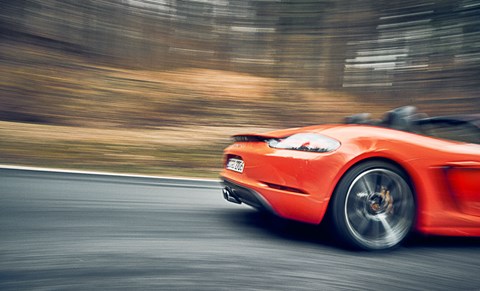
Even though the loudness and the snarling tone of voice prevail at all times, this single-turbo powerplant tends to paint monochrome sonic images. And although it is redlined at 7500rpm, it only takes 6500rpm to round up all 345 horses, so there’s no reason to wring it out like before. Especially since where the torque curve of the discontinued normally aspirated flat-six rose gently like the backrest of granddad’s lounge chair, the twist action signature of the new turbo motor is as geometric as a 1980s coffee table. Between 1900 and 4500rpm, there is 310lb ft to play with – plenty of clout but far less of that classic, high-revving character.
Remarkably, the 345bhp 2.3-litre Ford Ecoboost engine has mightier muscle. Not only does it lay on a beefier 324lb ft at 2000rpm, it also adds a 15-second 22lb ft full-throttle overboost bonus. The previous 2.5-litre five-cylinder in the Mk2 Focus RS was more rustic and less refined, but also more charismatic and violent, louder voiced and totally enjoying it – suiting the brutal demeanour of that front-wheel-drive rocket enough to forgive it co-founding the turbo-lag fan club.
The new car’s four-pot offering is far more rounded, flexible enough to cruise along at 50mph in sixth yet aggressive enough to chase BMWs and Porsches as soon as you say the word go, spinning up with unexpected smoothness to the tune of an artificially cultured growl.
Yet contrary to expectations of increased involvement, the manual transmission could do with a shorter throw, throttle response in the full-on Race mode is scarily skittish, and the fake lift-off backfiring that’s present in any setting beyond Normal is basically embarrassing. Not that the others are innocent of such transgression – the Boxster in particular.
BMW M2 on the road
That said, the M2 barely looks innocent of anything. Finished in gothic black inside and out, with the bulging wheelarches necessary to accommodate the wholesale M4 suspension components, it exudes tightly packed muscularity like The Rock stuffed into a normal-sized wetsuit.
By appearance it is by far the most threatening, even before you appreciate that BMW has dodged the downsizing bullet and packed a 3.0-litre straight-six under the bonnet, turbocharged to 365bhp and 369lb ft.
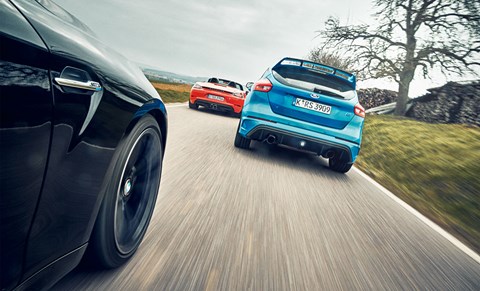
Though it’s true that six cylinders do not automatically guarantee superiority over the most modern of fours, they do usually sound more special and run more smoothly due to a special deal struck with the inertia forces. The latest M3 and M4 disrupt this melodic rule with their flat, dirgy tones, but it seems M Division has found its feet – or its ears – again here, for the M2 glories in a muted but distinct straight-six howl that urges you to push harder and harder.
Our car’s optional M DCT auto is at its best under paddle-flick control, where swift upshifts in DSC Sport are particularly rewarding, but it takes just 1450rpm to load up the M Differential, also borrowed from the M4, with the full complement of angle-altering thump. Be wary.
Acceleration times and top speed mattered more in the good old days before the sheer amount of traffic slowed everyone down. So while the unrestricted autobahn is useful for observing the Boxster’s tendency to really start drinking fuel above 125mph – downsizing be damned – the real challenge starts when we head out cross-country. After all, it’s easy for a fast car to do well in the smooth, controlled environs of a race track, but much harder to shine on the real-world turf of Heilbronn’s no-man’s land. Out here, where army tanks practice and mud-covered tractors appear without warning, it is absolutely essential to read the road. With so little margin for error, the stiff-hipped RS3 and A45 über-hatches from Audi and Mercedes-AMG would have a hard time, but the Focus RS is completely in its element.
This light blue five-door hatchback may lose a couple of tenths to the M2 and the Boxster S during those academic acceleration runs, but out here it can’t wait to claim them back again. Given a long enough stretch of twisties it will even start to carve out a small lead, such is its composure and tenacity. To beat the Ford against the stopwatch, both BMW and Porsche need those optional, extra-fast twin-clutch automatics, which lose almost no momentum during furious upshifts. To beat the RS on these roads, both premium contenders must pull out all the stops, and then some – a commitment that’s often much harder to make with only rear driven wheels.
Ford Focus RS: now a four-wheel drive hot hatch
For the Ford’s ever-eager engine is only part of its giant-stunning capability – it also owes a large portion of its halo to an adaptive four-wheel-drive system that addresses each wheel individually. At the front, this is common practice; at the rear, having two clutch units to distribute the twist action is an unheard of performance novelty cum exceptional innovation. Where other sporty all-wheel-drive models are perfectly happy with only a modest torque bias to the rear, the RS can send up to 70% not just to the tail end but potentially a single rear wheel – and that’s without Ken Block at the helm.
In the already notorious Drift mode, the blue streak can feel 150% rear-wheel drive. It’s probably for the best that while the adventurous nature of this awd system keenly encourages you to explore the full set of cornering attitudes, it does still take a conscious stab of that Drift button before the Focus will start killing flies with its side windows. Since such committed showing off is best left to a skid pad, the fingers of both hands were plenty to count the sidesteps ventured en route from Stuttgart to Würzburg. But count them we could – a revelation in a car of this type, and proof that all-wheel drive can rival rear-wheel drive for grandstanding entertainment.
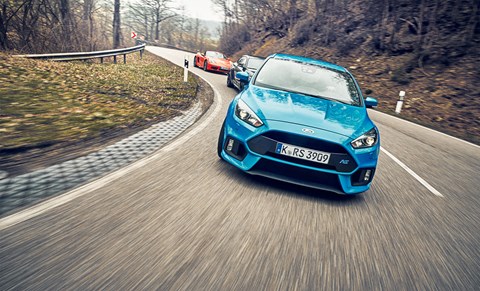
What the Ford lacks is a mix-and-match drive mode configuration. For example, you can’t have the more relaxed Normal steering weighting with the Sport engine set-up – unless you activate the Drift mode, which inevitably also manipulates the all-wheel drive to over-encourage misbehaviour at the rear; Drift permits daredevil leeriness, but it does so only in combination with a nervous tip-in/tip-out behaviour, and nervous-to-the-point-of-jerky steering. Fortunately, only the Race setting automatically activates the secondary – and super firm – damper mode, which is decidedly too firm for most roads. You can prod the end of the indicator to experiment with the suspension in other settings, but most will quickly decide the harder ride is not worth the disc-rupturing bother.
You won’t be shocked to learn that the M2 is hardly a role model for comfort and compliance, either. Its stiff shock absorbers are of the one-set-up-fits-all kind, the springs are as thick as spiral-shaped railway tracks, and the standard 19in Pilot Supersports are every bit as uncompromising as the slightly narrower Michelins fitted to the Ford and the extra-cost 20in P Zeros our Boxster S is equipped with. While it’s refreshing to find a carmaker that’s prepared to commit to a single suspension setting in 2016, over the really rough stuff the edgy, here-there-and-everywhere BMW is hard enough work to pepper palms with blisters. But then, what did you expect from a rebodied, short-wheelbase M4 clone?
‘The M2 immediately feels like a very serious piece of work’
Clone isn’t quite right, as not everything carries over. But if the engine’s down on power compared to big brother so is the weight, and as a result the M2 kicks just as hard. In fact, with its almost square stance and silky yet substantive responses it immediately feels like a very serious piece of work – more so than either of the others. You instinctively sense the need to pay attention, yet also that its talents run very deep. As soon as it hits smoother ground, the M2 duly morphs into a precise and responsive ground-hugging carver. Throw in a couple of second-gear corners, and the black ballerina will begin a new career as deep-voiced yet graceful solo dancer, wreathed in smoke that most definitely isn’t dry ice.
Compared to the old 1-series M coupe, which acted like a diviner at speed when a lack of downforce threatened to lift the front skirt Marylin Monroe-style, the M2 tends to rest deep within itself. Sudden lane changes? No effect on blood pressure and heart rate. Emergency braking manoeuvre on the autobahn? This car is a life insurance contract signed with brake dust and rubber marbles. Gearing? Long enough to satisfy eco-weenies, short enough to summon fifth at 125mph. Noise? Yes, and plenty of it, but not as intense as under the awning of the Boxster. And despite M Servotronic steering adjusting effort and response, the M2 feels well planted at all times, the feedback through the helm is consistently meaty, the cogs tuned for promptness and precision.
At 4-8 degrees C in a German forest, summer tyres may not be the choicest footwear. But they do tell a much clearer story about what r&d had in mind when it conceived these dramatically different musketeers. In the M2 and the Boxster more so than in the Focus RS, it is imperative to warm up the Michelins and Pirellis, as the M2 in particular becomes much more of a handful as the friction coefficient drops with the temperature. Putting heat into the driven wheels is easy as pie, but you also want the front end to stick, or there will be too much understeer and not enough turn-in grip.
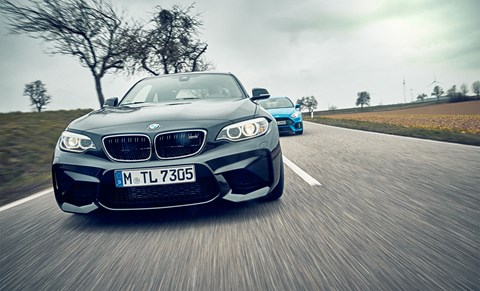
Such handling accurately reflects the vehicle’s DNA – and for all its four-wheel-drive trickery, the Focus is as neutral as Switzerland at the limit. Sounds a tad uninspiring but actually it’s a revelation, as somehow the fixed-rate steering ratio works in perfect synchronicity with the torque flow and the chassis movements. While the four-wheel drive displays its nip-and-tuck talents, the engine is as punchy and controlled as a slo-mo time bomb. Think we’re waxing overly lyrical? Then hop out and take a deep breath – the stink from the brakes and the tyres is exactly what a hard-charging chariot ought to smell like.
You sometimes need this olfactory emphasis from the Ford, as from behind the steering wheel the RS looks like little more than a tarted up Avis-or-Hertz-type Focus. Blue stitching and sports seats are the only indulgences that lift you beyond an ordinary experience. Likewise, the M2 is essentially a 1-series on steroids, stitched with M Division colours and scattered with logos but otherwise almost too ordinary for its own good. Until you spot those haunches in the door mirrors, and note that the overly-plump steering wheel in the M235i has been slightly reduced in both overall and rim diameter; like most weight-watchers, it could still do better in this regard but it is a feedback-enhancing improvement.
The Porsche, however, feels special the moment you open the door. Debatable Lava orange over black-brown livery aside, this particular specimen is a lametta-loaded Christmas tree on wheels that quickly has you overlooking the way the designers have seemingly flatted-back some of the original supercar curves in the 718 transition.
Porsche 718 Boxster: the lowdown
On board are bucket seats designed by a leptosome sadist, Torque Vectoring Plus mechanical diff lock, the PASM sport suspension, deft Servotronic Plus steering, said 20-inchers, carbon ceramic brakes, that sports exhaust and the Sport Chrono Package, to name only the most obvious temptations. Even though this specification clearly favours the sporty side of the car’s character, the ride is better than expected. Long undulations are no problem at all, transverse irritations don’t have an earthquake in tow, even low-speed ripples and potholes won’t destroy the self-assured posture. Although the three candidates are separated by mere nuances, the Porsche suspension is marginally less brusque.

Chassis modifications are measured in details rather than grand gestures. The steering is 10% faster, the suspension kinematics mildly tweaked, the electronic aids tuned for greater sensitivity – the aim being to increase overall drivability rather than hone the edge of the razor. The completeness of this strategy is immediately apparent. Compared to the antics of the Focus and the weighty, edgy presence of the M2, the Boxster S has a calmness and a purity that cuts straight to the sheer pleasure of piling on speed, the slick, finger-snap spontaneity of paddle-shifting the PDK only underlining its sense of immediacy. Don’t let it fool you, though – give it death, and the Boxster will still happily make its rear tyres scream for mercy.
New for this generation, the Sport Chrono Package adds the individual setting we’re bereft of in the Ford, in addition to the established Normal, Sport and Sport Plus calibrations – each accessed by the new circular control that sprouts from the hollow-spoked steering wheel. Plug in PDK as well, and the literal centre-point to this is the Sport Response Button, giving direct access to absolutely everything the engine and gearbox can muster, as if KITT came from Zuffenhausen. A fine party piece, but does the blown 2.5 four truly compensate for the plain-breathing 3.4 six’s dismissal?
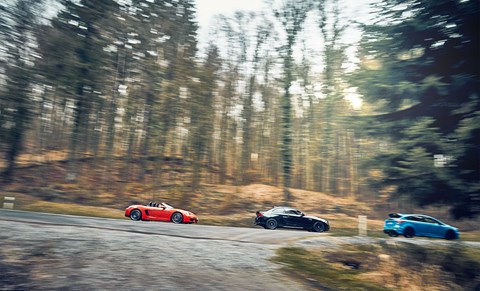
At first, you might think so. The soundtrack is initially hilarious and the boosted mid-range adds a superior sense of urgency. But as you tire of the engine’s shoutiness, you begin to doubt the veracity of Porsche’s claim that throttle response matches pre-718 levels. Certainly it doesn’t match these uncommon rivals. Flooring the loud pedal at 2000rpm in fourth – a perfectly common manoeuvre – creates a momentary blackout followed by a highly energetic kick in the butt.
Surprisingly enough, this however brief turbo lag remains an issue despite the variable-vane turbocharger, by-pass valving and ECU intelligence. Perhaps the long and complex breathing system demanded by the Boxster’s packaging constraints puts too much pressure on the solitary turbo. Whatever it is, we remain unconvinced that putting the official fuel economy on par with the M2 and RS was worth the resulting lack of incision.
The practical Porsche
With two perfectly useable luggage compartments belying the compromises associated with roadsters, the Porsche remains beautifully made, good looking and generally hard to fault. It is the quickest contender here by a tiny margin, it has the sweetest steering, and as far as the stats go, the four-cylinder engine ticks all the right boxes. So if money is no object and you aren’t tainted by six-cylinder nostalgia, the 718 could have your name written all over it. The BMW makes its bid for victory with captivating menace, the smoke signals-per-mile ranking and the Slidemeister medal. In essence, the M2 is the real successor to the M3 – immensely chuckable, outright rowdy, wonderfully temperamental, within reach of more budgets.
But this heart beats fastest of all for the Focus RS. Even ignoring all thoughts of practicality – roomiest cabin, biggest boot, lowest price tag – the Ford’s intoxicating blend of special Q-car surprise factor and sensational dynamic ability means that without doubt, Henry’s finest this side of the GT has got everything it takes to play the game at the same high level as Boxster S and M2. And that is an astonishing achievement.
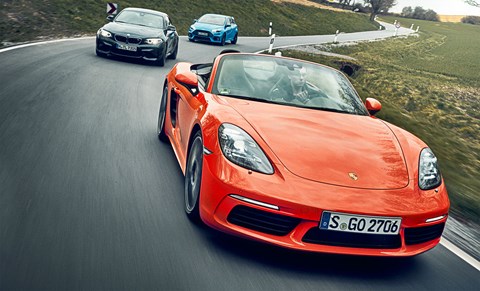
Do it secondhand: same fun, different budget
Porsche Boxster S 3.4 987 (2004-2012) from £12,500
Early Mk2 Boxsters are now available under £10k, but spend at least £15k if you can. Full service history and condition more important than mileage, with worn suspension, cracked manifolds and oils seals worth attention.
Ford Focus ST (2005-2010) from £5000
With previous Focus RS prices rocketing, the Mk2 Focus ST with its throaty 222bhp five-pot is our choice for a used fast-Ford bargain. Just watch for split bore liners, dubious mods and ruined front tyres.
BMW E46 M3 (2000-2006) from £7500
Its 338bhp straight-six might be missing a turbo, but this is the M2’s true spiritual predecessor – and it’s way cheaper than a used M235i. Cracked rear subframes, early engines and SMG auto issues best avoided.
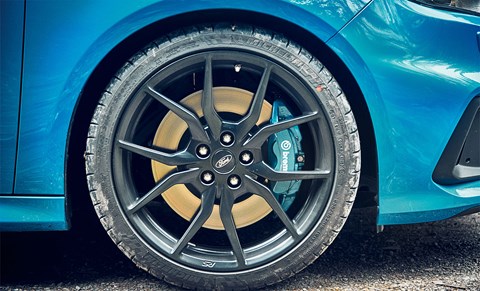
Paper, scissors and stone! Who’s best at what
Ford wins our test, but whose side are you on in the bigger range game?
Ford beats BMW – at MPVs
Canny S-Max is not only a packaging and tech delight, but shockingly also trumps underbaked 2-series Active Tourer for driving dynamics. Faced with a front-drive brief, BM’s rear-drive gurus were caught napping – although not in the 2’s excrutiatingly uncomfy third row of seats, we’ll wager.
BMW beats Porsche – at limos
Forty years of limo know-how went into the current, incredible 7-series and its masterchef blend of refinement, tech and ace handling. Porsche decoded that learning as ‘make it handle and sod the back seats’, resulting in the Panamera: a four-door for 911 fans with more than one friend.
Porsche beats Ford – at SUVs
For Ford’s perfectly decent Kuga the news that Porsche was planning a compact SUV was ‘I’ll get me coat’ time. Sure enough, the Macan was a fantastic drive, beautifully built and tilted its hat seductively at ambitious Kugarati. It also had just enough off-road cred to traverse its own pricetag.
Read more features from the May 2016 issue of CAR magazine here
